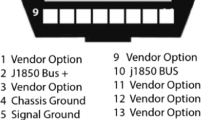Abstract
In recent years, the use of advanced technologies such as wireless communication and sensors in intelligent transportation systems has made a significant increase in traffic data available. With this data, traffic prediction has the ability to improve traffic conditions and to reduce travel delays by facilitating better utilization of available capacity. This paper presents a real-time transportation prediction system named VTraffic for Vermont Agencies of Transportation by integrating traffic flow theory, advanced sensors, data gathering, data integration, data mining and visualization technologies to estimate and visualize the current and future traffic. In the VTraffic system, acoustic sensors were installed to monitor and to collect real-time data. Reliable predictions can be obtained from historical data and be verified and refined by the current and near future real-time data.










Similar content being viewed by others
Notes
There are 56 sensors deployed on I89 and I91, 28 for each. The location details can be found at http://cs.uvm.edu/~hli/www/traffic/html/sensorlocations.htm.
References
Schrank D, Lomax T, Eisele B (2011) Urban mobility report. Technical report, Texas Transportation Institute
Chien SIJ, Liu X, Ozbay K (2007) Predicting travel times for the south jersey real-time motorist information system. J Transp Res Board 1885(2003):32–40
Aksaç A, Uzun E, Özyer T (2012) A real time traffic simulator utilizing an adaptive fuzzy inference mechanism by tuning fuzzy parameters. Appl Intell 36:698–720
Wu J, Abbas Turki A, El Moudni A (2012) Cooperative driving: an ant colony system for autonomous intersection management. Appl Intell 37:207–222
Lu E, Lee W, Tseng V (2011) Mining fastest path from trajectories with multiple destinations in road networks. Knowl Inf Syst 29:25–53
Castillo E, Nogal M, Menéndez JM, Sánchez-Cambronero S, Jiménez P (2012) Stochastic demand dynamic traffic models using generalized beta-Gaussian Bayesian networks. IEEE Trans Intell Transp Syst 13(2):565–581
FHWA (2011) FHWA operations—operations story
Basicevic I, Kukolj D, Popovic M (2011) On the application of fuzzy-based flow control approach to high altitude platform communications. Appl Intell 34:199–210
Warden T, Visser U (2012) Real-time spatio-temporal analysis of dynamic scenes. Knowl Inf Syst 32:243–279
Google Fusion Table. https://www.google.com/fusiontables/
Google Maps. http://code.google.com/apis/maps/
Tan J, Lu E, Tseng V (2012) Preference-oriented mining techniques for location-based store search. Knowl Inf Syst 1–23. doi:10.1007/s10115-011-0475-4
Vaisala Homepage. http://www.vaisala.com/
Pisano PA, Goodwin LC, Rossetti MA (2008) US highway crashes in adverse road weather conditions. In: Proceedings of the 88th American meteorological society annual meeting, New Orleans, Louisiana
Pisano P (2009) Clarus success stories: using clarus data to improve operations. Technical report FHWA-JPO-10-005, US Department of Transportation Road Weather Management
Available at: http://www.clarus-system.com/
Bohlooli A, Jamshidi K (2012) A gps-free method for vehicle future movement directions prediction using som for vanet. Appl Intell 36(3):685–697
Athitsos V, Alon J, Sclaroff S (2005) Efficient nearest neighbor classification using a cascade of approximate similarity measures. In: Proceedings of the 2005 IEEE conference on computer vision and pattern recognition, Washington, DC, USA, pp 486–493
Liu H, Motoda H, Setiono R, Zhao Z (2010) Feature selection: an ever evolving frontier in data mining. J Mach Learn Res 10:4–13
Altinçay H, Erenel Z (2012) Using the absolute difference of term occurrence probabilities in binary text categorization. Appl Intell 36:148–160
Battiti R (1994) Using mutual information for selecting features in supervised neural net learning. IEEE Trans Neural Netw 5:537–550
Peng H, Long F, Ding C (2005) Feature selection based on mutual information criteria of max-dependency, max-relevance, and min-redundancy. IEEE Trans Pattern Anal Mach Intell 27(8):1226–1238
Kenji K, Rendell LA (1992) The feature selection problem: traditional methods and a new algorithm. In: Proceedings of the 10th national conference on artificial intelligence, pp 129–134
Yang S, Hu B (2012) Discriminative feature selection by nonparametric Bayes error minimization. IEEE Trans Knowl Data Eng 24(8):1422–1434
Kurgan LA, Cios KJ (2004) Caim discretization algorithm. IEEE Trans Knowl Data Eng 16:145–153
RITIS system. https://www.ritis.org/
Brown G, Pocock A, Zhao MJ, Luján M (2012) Conditional likelihood maximisation: a unifying framework for information theoretic feature selection. J Mach Learn Res 13:27–66
John GH, Langley P (1995) Estimating continuous distributions in Bayesian classifiers. In: Proceedings of the 11th conference on uncertainty in artificial intelligence, CA, USA, pp 338–345
Quinlan JR (1996) Bagging, boosting, and c4.5. In: Proceedings of the 13th national conference on artificial intelligence, pp 725–730
Breiman L (2001) Random forests. Mach Learn 45(1):5–32
Author information
Authors and Affiliations
Corresponding author
Additional information
This work is supported by Vermont Agencies of Transportation under grant No. 000025425. An earlier version of this paper was presented at the 25th International Conference on Industrial, Engineering & Other Applications of Applied Intelligent Systems.
Rights and permissions
About this article
Cite this article
Li, H., Li, Z., White, R.T. et al. A real-time transportation prediction system. Appl Intell 39, 793–804 (2013). https://doi.org/10.1007/s10489-012-0409-1
Published:
Issue Date:
DOI: https://doi.org/10.1007/s10489-012-0409-1




